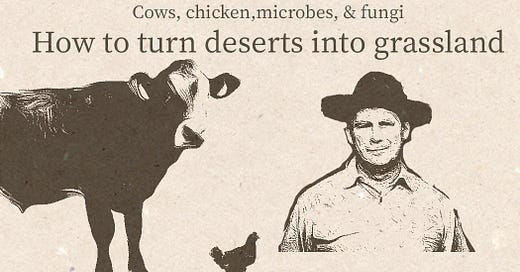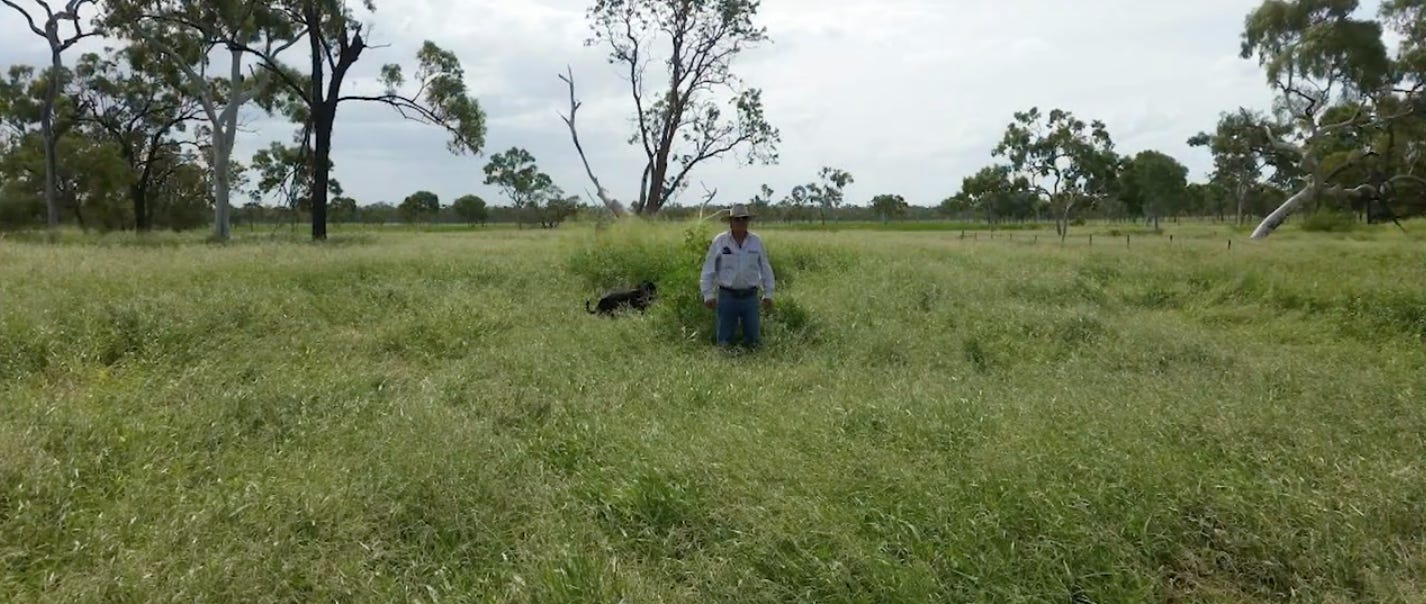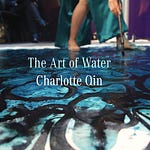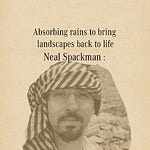Growing up in, and having worked in the Holistic Management ecorestoration movement that his dad Alan Savory began, Rodger Savory, an ecologist, land manager, and ranch owner, was searching for the biggest and most significant problem he could find.
The problem he decided to try and solve, was that of halting the exponential spread of deserts by returning the deserts back to grasslands.
In Zambia and Zimbabwe, where the shade could be 120 degrees Fahrenheit, and where the wet and dry season intersected with the land in a way that increased the risk of desertification, he began experimenting on his ranch lands. He could see early on that the cow manure had an effect on growth. Why exactly, though was not entirely clear.
He had herds of cattle move across the land, ‘like caterpillars crawling across the desert’, laying out a carpet of manure. The experiments would take a week or so, and then he had to frustratingly wait a year to see what the results were. If the cattle moved too slow or too fast the results were not as good. If the density of cattle per area was not optimal, it affected how much growth happened.
He did many different experiments, and went down many dead ends. At one point he noticed that when the layer of dung contained sheep and goat pellets were, the grass grew more. Why was that, he wondered, which ingredient in the pellet was responsible? He chased this idea for a couple of years, before a large four inch rain came and washed away all the pellets.
He experimented with having sheep and goat in addition to the cattle. After awhile he realized that what was in the sheep or goat or cow manure didn’t matter so much as the role that the layer of manure provided in covering the ground to create the right conditions for growth underneath.
Microbes are key to the development of the soil. Reproducing in 10 minutes, they can grow to large numbers exponentially fast. But only in the right conditions. The microbes need to have access to nutritious liquid - something which can be provided by the animal urine. The microbes also need to be shielded from the ultraviolet rays from the sun, otherwise they get fried - a fact that he only figured out many years into the experiments when a woman civil engineer doggedly quizzed him on to explain what was happening. The role of the layer of manure above the microbes is to both protect the urine from drying out, and to guard against the ultraviolet rays.
Fungi, it became clearer as the experiments progressed, was also key to the whole equation. Rodger noticed that when the mycelia tapped on the seeds, the seeds would open and start to grow. The mycelia also spread out in a network to build the soil. The layer of dung and urine provided the cool, wet, dark conditions that mycelia thrive in.
The cattle were fed forage that contained fungi spores, grass seeds, and tree seeds. Elements that were then pooped out in the dung. In order for the seeds to grow, though, the layer of cow dung could not be too deep. Gardeners know if mulch is too thick, seeds won’t sprout through. Rodger puzzled how to get the layer of cow dung to be more uniform at the right thickness, given that cows don’t poop uniformly.
After awhile he figured chickens were the solution. They released chickens into the field after the cattle, and their pecking and wandering spread the cow manure to a more consistent and correct depth.
The land was then left to be on its own. The seeds would start sprouting and growing grass, which lead to the building of nutrients and soil. When the sparse deserts rains came, they could then get absorbed into the land to help grow life, rather than become runoff that raced off the land.
The use of cows fed forage with fungi, grass seeds and tree seeds laying dung followed by chickens to spread it out was the methodology that they figured out and understood over the course of 25 years. They called this the biological carpet approach.
The fastest a piece of land has regenerated is six weeks. In Zimbabwe, they timed the laying of biological carpet just right, with the rains coming right after, so the grass grew quickly.
After succeeding with this method in Africa, Rodger and his team reproduced similar results at 9000 feet in the high alpine deserts of Colorado. This was followed by successful experiments in Canada and Australia.
In Australia cattle came onto the land for a day and a half, left their poop, and then over the next few months the land regenerated. Here is a before and after picture in Australia:
An intriguing phenomena they noticed as grasslands grew back is that in the mornings there would be a mist hanging above the grass. This happened even if it had not been raining for months. The water would be released by the land, add to the water vapor in the air, form a mist, and then go back down to hydrate the vegetation and soil. Its a different way of hydrating than is commonly recognized. Rodger calls this the micro-water cycle - as distinct from the small water cycle which is where the water travels high up into the sky to create clouds, before it returns as rain. The microwater cycle does not create rain, while the small water cycle does.
Over time as the biological carpet is able to store my rain, it will also be able to evapotranspire more to help create more rain in the area. Rodger’s land would have more rain, while his neighbors would have less. The neighbors complained he was lucky, he told them that they too could get this same effect. And it seems they are now starting to get this chain of causality. This was a similar effect that Judith Schwartz noted went she went down to Mexico. The Mexican farmer she interviewed, who had regenerated his lands, had more rain than his neighbors. The pieces of land in both Rodger’s case and the Mexicans were quite large so they could generate enough water vapor, and affect land heat fluxes to affect rain patterns. Trees on the land that slowed winds, and bioaerosols released by the vegetation probably also helped increase the rain.
Rodger says “The biological carpet is just to jump start the lifecycle. Once the lifecycle is able to get started, get out of its say……… Life begets life. More life begets more life”. And it can be added - life begets water, water begets more life, with a nod to a similar Millan Millan quote.
Modern civilization has degraded land and destroyed the life on it, lessening its ability to self-organize, self-regulate, reproduce and regenerate. Deserts are an extreme aspect of that degradation, they are limited in their ability to turn rain and sunlight into the long photosynthetic carbon chains of life. Deserts though, do not have to be a permanent equilibrium dead end that the complex system of the earth evolves to and is stuck at. The biological carpet provides a way to jump start the positive feedback loop of life creating more life again.
Rodger has set his eyes on California for his next project. The idea is to regreen the desert in the Imperial Valley in southeast California. Rodger says pollen and other evidence point to Imperial Valley and other desertified areas in south eastern California as being more green and vegetated historically, with past civilizational mishaps weakening the landscape ecology.
The idea is to start in the Imperial Valley with a 5000-6000 acres of land to show proof of concept, then approach the California government to help them obtain 150,000 acres of land to regreen.
Currently the Imperial Valley gets about 3 inches of rain yearly, and it all rushes off the land because there is nothing to absorb it. With a biological carpet there, when the infrequent rains come, more of that rain can be absorbed to grow grasslands first, and trees later.
The extreme desert temperature oscillations from very hot to very cold, will be dampened by the biological carpet and growing soil. This will lead to less hot daytime winds. With more humidity in the environment, the winds will also be less dry. The recent scourge of wildfires in Calfornia have been fanned by the hot, dry Chinook winds that blow in from southeastern Calfornia. With less hot, and less dry winds there should be a decrease in wildfires.
As grass and trees grow, rains can return, as there is more water vapor evapotranspiring to combine with the air moisture to create rain. Rain can moisture hop, via the small water cycle, around California to increase its water supply. Winds blowing up from the Baja California can carry the extra water vapor from Imperial Valley into the continental US, to places like Kansas and Texas.
Rodger is looking to initiate this project in the Imperial Valley, with 5000-6000 acres and several thousand cattle. If he can show this works he will then approach Californian government for more land.
You can read more about his project at fixdeserts.com . You can subscribe to his project on the website. Subscription helps when they show proof of interest in the project to the California government. If you have the connections, you can pass the idea onto potential investors.
…………………………………………………………………………………………………………..
A while back I interviewed climate scientist Millan Millan who figured out that the rains were being lost in Spain because the now degraded land could not bring down the water vapor that was blowing from the Atlantic to the Mediterranean Sea. Then I interviewed Ties Van Der Hoeven, who was working with Millan Millan about his regreening the Sinai desert project, which would help bring down the water vapor that was blowing from the Mediterranean Sea to the Red Sea. That extra water brought down could then moisture hop into Africa and the Middle East. Both these cases are continental divides, places that divided two large bodies of water, a key factor in why they are so important, as the water vapor would otherwise be blown back out to sea. If the water could be brought down when it travelled between those two bodies then that set in motion a long chain of hydrological effects. Ties considered these places to be acupoints - regreening them would have lots of climatic ripple effects on neighboring lands.
After that interview I wondered if there were other continental divides that could be key climatic acupoints. After perusing the globe for awhile, I realized that there were ocean winds blowing from the Pacific over southern California, and into the Gulf of California, and also vice versa. If more of that water vapor could be brought down onto the desertified lands in south-eastern California, instead of being lost back out to sea, then when that water evapotranspired it could be blown further inland by winds that would take it to the Colorado River. (Scientific research has found that air moisture is transported from California to the mid-west. The droughts in the US mid-West in 2012 were in part due to the droughts in California, as there was a decrease in moisture hopping.)
Regreening areas in southeast California could thus be a potential solution to deal the water shortages in the western US states, as they depend on the amount of rainfall the Colorado River gets. (I hope to find some climate scientist to model the magnitude this effect.)
I was then very excited to stumble on the work of Rodger Savory (on Hart Hagan’s youtube channel) , and hear of his plans to regreen deserts in south-eastern California, and to restore rain in California and states beyond. I was delighted when he agreed to come on and do this podcast.
…………………………………………………………………………………………………….
This is a reader supported publication.
















Share this post